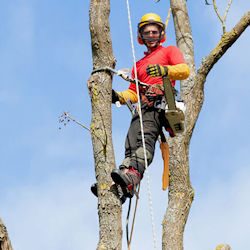31.B.14 Climbing techniques.
The climber may apply a variety of climbing techniques, but they must be approved by the GDA.
- Climbing without the use of tree spurs may be required.
- The most commonly used arborist rope climbing technique is the "Advancing the Rope and Body Thrusting/Alternate Lanyard Technique".
- If the climber can remain near the trunk of the tree, he may use both the belt lanyard/flip line and the Rope Advance (lifeline) technique. Otherwise, a single line access is permitted. If a lifeline (Access Line) cannot be set in the tree, then the use of two flip lines may be used.
- The use of auto-locking belay devices or tree climber's hitches is both permitted.
- Climbers must not ascend above their tie in point. Tie-in points must be well above the climber to prevent an uncontrolled pendulum swing in the event of a slip.
- Once in the tree, climbers must be tied off at two points while working or using the chainsaw, (this includes the primary support of the access line or climbing line, and secondary support with a second climbing line or the flip line/lanyard/buck strap).
- (1) Climbers may ascend or descend from the tree using only the access line by using approved single rope techniques.
- (2) Once the worker is at the tie-in point, a secure climbing system must be installed.
- (3) The climber must disconnect from the access line only when a new tie in point has been established.
- Use of the three-point contact climbing is recommended if possible. Climbers may use ground personnel to help pull them up the tree.
- Tree climbers must be medically cleared every 2 years by a licensed healthcare provider for unlimited tree climbing. The examination will have an emphasis on identifying and providing mitigating factors for prior heat/cold injuries, the ability to work at heights on uneven surfaces, and any environmental allergens. Additionally it will ensure that there are no medical conditions or medications which could affect balance, the ability to communicate with others, level of consciousness, extremity sensation, fine motor movement, gross motor movement, or the ability to physically lift or lower oneself.
Knowledge Check Choose the best answer for the question.
31-5. Once in the tree, what is required when climbers are using a chainsaw?
You forgot to answer the question!

